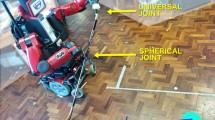Abstract
To improve the flexibility of robotic learning, it is important to realize an ability to generate a hierarchical structure. This paper proposes a learning framework which can dynamically change the planning space depending on the structure of tasks. Synchronous motion information is utilized to generate ’modes’ and hierarchical structure of the controller is constructed based on the modes. This enables efficient planning and control in low-dimensional planning space, though the dimension of the total state space is in general very high. Three types of object manipulation tasks are tested as applications, where an object is found and used as a tool (or as a part of the body) to extend the ability of the robot. The proposed framework is expected to be a basic learning model to account for body schema acquisition including tool affordances.
Similar content being viewed by others
Explore related subjects
Discover the latest articles, news and stories from top researchers in related subjects.References
Asada, M., MacDorman, K., Ishiguro, H., Kuniyoshi, Y.: Cognitive developmental robotics as a new paradigm for the design of humanoid robots. Robot. Auton. Syst. 37, 185–193 (2001)
Atkeson, C.G., Moore, A.W., Schall, S.: Locally weighted learning. Artif. Intell. Rev. 11, 11–73 (1997)
Bemporad, A., Morari, M., Dua, V., Pistikopoulos, E.: The explicit linear quadratic regulator for constrained systems. Automatica 38(1), 3–20 (2002)
Blakemore, S.J., Wolpert, D.M., Frith, C.D.: Abnormalities in the awareness of action. Trends Cogn. Sci. 6(6), 237–242 (2002)
Brooks, R.A.: A robust layered control system for a mobile robot. IEEE J. Robot. Autom. RA-2, 253–262 (1986)
Dayan, P., Hinton, G.E.: Feudal reinforcement learning. In: Giles, C.L., Hanson, S.J., Cowan, J.D. (eds.) Advances in Neural Information Processing Systems, vol. 5, pp. 271–278 (1993)
Demiris, Y., Dearden, A.: From motor babbling to hierarchical learning by imitation: a robot developmental pathway. In: Berthouse, L., et al. (eds.) Proc. of the Fifth Int. Workshop on Epigenetic Robotics, pp. 31–37. Japan (2005)
Demiris, Y., Meltzoff, A.: The robot in the crib: a developmental analysis of imitation skills in infants and robots. Infant Child Dev. 17, 43–53 (2008)
Drescher, G.L.: Made-Up Minds: A Constructivist Approach to Artificial Intelligence. MIT (1991)
Gibson, J.J.: The theory of affordances. In: Perceiving, Acting, and Knowing: Toward Ecological Psychology, pp. 62–82. Lawrence Erlbaum, NJ (1977)
Hauskrecht, M., Meuleau, N., Boutilier, C., Kaelbling, L.P., Dean, T.: Hierarchical solution of markov decision processes using macro-actions. In: Proc. of 14th Annual Conference on Uncertainty in Artificial Intelligence, pp. 220–222 (1998)
Khalil, H.K. (ed): Nonlinear Systems. Prentice Hall (2001)
Kuniyoshi, Y., Sangawa, S.: Early motor development from partially ordered neural-body dynamics: experiments with a cortico-spinal musculo-skeletal model. Biol. Cybern. 95, 589–605 (2006)
Lavalle, S.M.: Planning Algorithms. Cambridge University Press (2006)
Lungarella, M., Metta, G., Pfeifer, R., Sandini, G.: Developmental robotics: a survey. Connect. Sci. 15(4), 151–190 (2003)
Mangasarian, O.L., Musicant, D.R.: Lagrangian support vector machines. J. Mach. Learn. Res. 1, 161–177 (2001)
Maravita, A., Iriki, A.: Tools for the body (schema). Trends Cogn. Sci. 8(2), 79–86 (2004)
Metta, G., Fitzpatrick, P.: Early integration of vision and manipulation. Adapt. Behav. 11(2), 109–128 (2003)
Michael Kass, A.W., Terzopoulos, D.: Snakes: active contour models. Int. J. Comput. Vis. 1(4), 321–331 (1988)
Miyamoto, H., Morimoto, J., Doya, K., Kawato, M.: Reinforcement learning with via-point representation. Neural Netw. 17, 299–305 (2004)
Nabeshima, C., Kuniyoshi, Y., Lungarella, M.: Adaptive body schema for robotic tool use. Adv. Robot. 20(10), 1105–1126 (2006)
Nelder, J.A., Mead, R.: A simplex method for function minimization. Comput. J. 7, 308–313 (1965)
Oyama, E., Agah, A., MacDorman, K.F., Maeda, T., Tachi, S.: A modular neural network architecture for inverse kinematics model learning. Neurocomputing 38–40, 797–805 (2001)
Ratitch B., Precup D.: Using MDP Characteristics to Guide Exploration in Reinforcement Learning. Springer, Berlin (2003)
van der Schaft, A., Schumacher, H.: An Introduction to Hybrid Dynamical Systems. Springer (2000)
Siméon, T., Laumond, J.P., Cortés, J., Sahbani, A.: Manipulation planning with probabilistic roadmaps. Int. J. Rob. Res. 23(7–8), 729–746 (2004)
Stoytchev, A.: Behavior-grounded representation of tool affordances. In: Proc. of IEEE Int. Conf. on Robotics and Automation, pp. 3071–3076. Barcelona, Spain (2005)
Stoytchev, A.: Toward video-guided robot behaviors. In: Proc. of the Seventh International Conference on Epigenetic Robotics, pp. 165–172. Rutgers University, NJ (2007)
Vapnik, V.N.: The Nature of Statictical Learning Theory. Springer (1995)
Wolpert, D.M., Kawato, M.: Multiple paired forward and inverse models for motor control. Neural Netw. 11, 1317–1329 (1998)
Xu, C., Prince, J.L.: Snakes, shapes, and gradient vector flow. IEEE Trans. Image Process. 7(3), 359–369 (1998)
Yoshikawa, Y., Hosoda, K., Asada, M.: Does the invariance in multi-modalities represent the body scheme?—A case study with vision and proprioception—. In: Proc. of the 2nd Int. Symp. on Adaptive Motion of Animals and Machines, vol. SaP-II-1 (2003)
Author information
Authors and Affiliations
Corresponding author
Rights and permissions
About this article
Cite this article
Kobayashi, Y., Hosoe, S. Planning-Space Shift Motion Generation: Variable-space Motion Planning Toward Flexible Extension of Body Schema. J Intell Robot Syst 62, 467–500 (2011). https://doi.org/10.1007/s10846-010-9465-0
Received:
Accepted:
Published:
Issue Date:
DOI: https://doi.org/10.1007/s10846-010-9465-0




